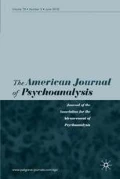Ask for three things: a good wife, a good year, a good dream.
Anonymous
References
Rosten, L.Treasury of Jewish Quotations. New York: McGraw-Hill, 1972, p. 191.
Psychological Abstracts 1 (1927):691.
Psychological Abstracts 47 (1972):268–269.
Freud, S. “The Interpretation of Dreams.” InStandard Edition of the Complete Psychological Works of Sigmund Freud, vol. 4, J. Strachey (ed.). London: Hogarth, 1953.
Hartmann, E.Sleep and Dreaming. Boston: Little, Brown, 1970.
Jones, R. M.The New Psychology of Dreaming. New York: Grune & Stratton, 1970, p. 1.
Rossi, E. L.Dreams and the Growth of Personality. New York: Pergamon, 1972.
Dietz, P. A.Mensch en Droon (Man and his Dreams). Leiden: Sijthoff, 1935, p. 254.
Mayer, F. “La structure du rêve” (The structure of dreams). Arch. Psychol. (Geneve) 25 (1935): 129–156.
Giora, Z. “The Function of the Dream: A Reappraisal.”Am. J. Psychiatry 128 (1972): 1067–1073.
Snyder, R. “Toward an Evolutionary Theory of Dreaming.”Am. J. Psychiatry 123 (1966): 121–135.
Othmer, E., Hayden, M. P., and Segelbaum, R. “Encephalitic Cycles During Sleep and Wakefulness in Humans: A 24-hour Pattern.”Science 164 (1969):447–449.
Fisher, C., and Dement, W. C. “Studies on the Psychopathology of Sleep and Dreams.”Am. J. Psychiatry 119 (1963):1160–1168.
Dement, W. C. “Studies on the Function of Rapid Eye Movement (Paradoxical) Sleep in Human Subjects.” InAspects Anatomo-Finctionelles de la Physiologie du Sommeil, M. Jouvet (ed.). Paris: Centre National de la Recherche Scientifique, 1965, pp. 571–611.
Lerner, B. “Dream Function Reconsidered.”J. Abnorm. Psychol. 72 (1967):85–111.
Greiser, C., Greenberg, R., and Harrison, R. H. “The Adaptive Function of Sleep: The Differential Effects of Sleep and Dreaming on Recall.”J. Abnorm. Psychol. 80 (1972): 280–286.
Brenner, C. “Some Comments on Technical Percepts in Psychoanalysis.”J. Am. Psychoanal. Assoc. 17 (1969):333–352.
Wolpert, E. A. “Two Classes of Factors Affecting Dream Recall.”J. Am. Psychoanal. Assoc. 20 (1972):45–58.
Fisher, J., and Breger, L. (eds.)The Meaning of Dreams: Some Insights from the Laboratory. Calif. Mental Health Res. Symp., 1969, no. 3.
Robbins, M. C., and Kilbride, P. L. “Sex Differences in Dreams in Uganda.”J. Cross-Cult. Psychol. 2 (1971):406–408.
Paramelle, F. “L'imaginaire et le symbolique dans le fantasme” (The Imaginary and the Symbolic in Fantasy).Rev. Fr. Psychanal. 35 (1971):373–385.
Van de Castle, R. L. His, Hers and the Children's.Psychol. Today 4 (1970):37–39.
Greenson, R. The Exceptional Position of the Dream in Psychoanalytic Practice.Psychoanal. Q. 39 (1970):519–549.
Roland, A. “The Context and Unique Function of Dreams in Psychoanalytic Therapy: Clinical Approach.Int. J. Psychoanal. 52 (1971):431–439.
Dreistadt, R. “An Analysis of How Dreams are Used in Creative Behavior.”Psychology 8 (1971):24–50.
Dreistadt, R. “A Unifying Theory of Dreams, a New Theory of Nightmares, and the Relationship of Nightmares to Psychopathology, Literature, and Collective Social Panic Behavior.”Psychology 9 (1972):19–30.
Whitman, R. M., Kramer, M. and Baldwin, B. J. “Dreams About the Patient: An Approach to the Problem of Countertransference.”J. Am. Psychoanal. Assoc. 17 (1969):702–727.
Garcia-Barroso, M. “Quelques remarques sur les reveries, les reves et les fantasmes inconscients” (Some Remarks on Reveries, Dreams and Unconscious Fantasies).Rev. Fr. Psychanal. 35 (1971):409–417.
Breger, L., Hunter, I. and Lane, R. W. “The Effects of Stress on Dreams.”Psychol. Issues 7 (1971).
Zinker, J. C. “Dreamwork as Theater.”Voices: Art & Sci. Psychother. 7 (1971): 18–21.
Kramer, M. “Manifest Dream Content in Normal and Psychopathologic States.”Arch. Gen. Psychiatry 22 (1970):149–159.
Kramer, M., Winget, C. and Whitman, R. M. “A City Dreams: A Survey Approach to Normative Dream Content.”Am. J. Psychiatry 127 (1971):1350–1356.
Kramer, M., Whitman, R. M., Baldridge, B. J., and Ornstein, P. “Dream Content in Male Schizophrenic Patients.”Dis. Nerv. Syst. 31 (1970):51–58.
Gereb, G., Szabo, Z. and Oestreich, G. “Erlebnisgehalte von Traumen ungarischer Schuler” (Dream Contents in Hungarian Pupils).Prax. Kinderpsychol. Kinderpsychiatr. 19 (1970): 300–316.
Foulkes, D. “Drug Research and the Meaning of Dreams.”Exp. Med. Surg. 27 (1969):39–52.
Domino, G. “Primary-Process Thinking in Dream Reports and Creative Achievement.”Proc. Ann. Conv. Am. Psychol. Assoc. 5 (1970):481–482.
Calef, V. “‘I am awake’: Insominia or Dream? An Addendum to the Forgetting of Dreams.”Psychoanal. Q., 41:161–171, 1972.
Markowitz, I., Taylor, G., and Bokert, E. “Dream Discussion as a Means of Reopening Blocked Familial Communication.”Psychother. Psychosom. 16 (1968):348–356.
Markowitz, I., Bokert, E., Sleser, I., and Taylor, G. “A Cybernetic Model of Dreaming: A Basis for Understanding the Interpersonal Context of Children's Dreams.”Psychiatr. Q. (Suppl.) 41 (1967):57–68.
Jones, W. L. “Manifest Dream Content: An Aid to Communication During Analysis.”Am. J. Psychother. 25 (1971):284–292.
Stewart, R. A. “Factors Promoting Effective Psychotherapy: A Modeling Analysis of Patient and Therapist.”Percept. Mot. Skills 32 (1971):747–752.
Hall, C. S., and Van de Castle, R. L.The Content Analysis of Dreams. New York: Appleton-Century-Crofts, 1966.
Gershman, H. “The Use of the Dream in the Therapy of Homosexuality.”Am. J. Psychoanal. 31 (1971):80–94.
Krohn, A., and Gutmann, D. “Changes in Mastery Style With Age: A Study of Navajo Dreams.”Psychiatry 34 (1971):289–300.
Gutheil, E. A. Personal communication.
Author information
Authors and Affiliations
Additional information
Delivered January 23, 1974, for the Association for the Advancement of Psychoanalysis.
Reprint requests to 7 Park Avenue, New York, N.Y. 10016
Rights and permissions
About this article
Cite this article
Miller, C.H. Dreams and dreaming: The current state of the art. Am J Psychoanal 35, 135–146 (1975). https://doi.org/10.1007/BF01358185
Issue Date:
DOI: https://doi.org/10.1007/BF01358185

